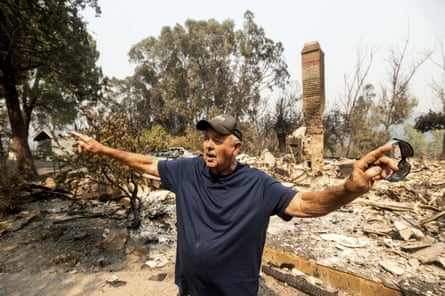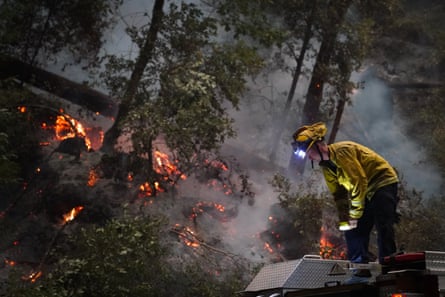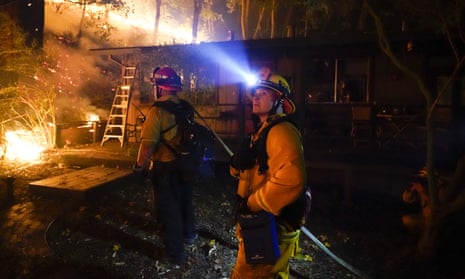Firefighters in California prepared on Sunday for high winds and thunderstorms that threatened to spark new blazes and further spread existing fires, as officials warned capacity was stretched to levels “not seen in recent history”.
Progress was made against three massive and destructive wildfires during a calm stretch overnight on Saturday. However the The National Weather Service (NWS) has issued a “red flag” warning through Monday afternoon for the drought-stricken area, meaning extreme fire conditions including high temperatures, low humidity and wind gusts up to 65mph could result in “dangerous and unpredictable fire behavior”.
The “complexes”, or groups of fires, were burning on all sides of the San Francisco Bay Area, and have destroyed nearly 1,000 homes and structures and forced tens of thousands to evacuate. Ignited by nearly 12,000 lightning strikes across the state in the past week, the fires have claimed six lives so far and have burned significantly more acres than all of the fire damage in 2019. Officials are now seeking assistance from states across the US, as well as Canada and Australia.
Shana Jones, chief for Cal Fire’s Sonoma-Lake-Napa unit, said the state’s resources were “stretched to capacity that we have not seen in recent history”, and noted at a Sunday news conference that even with an influx of support, there were still huge challenges: “We are definitely far from getting these fires handled. We are not out of the woods by far.”
With the red flag warning in place, she urged residents to be prepared to evacuate at any moment, and advised them to consider evacuating if they are concerned, even if orders aren’t in place: “Be ready to leave in the dead of night if it comes to that. If your sixth sense just says I need to leave, then please do so. Do not wait to be told to leave.”
At a morning briefing on the so-called CZU Lightning Complex fire in the Santa Cruz Mountains south of San Francisco, officials said they had increased containment to 8% and with the better weather on Saturday dug more protective lines around vulnerable communities, including the University of California, Santa Cruz.
But there is concern about the weather and the thunderstorms that will bring high winds and “dry” lightning, a term used when such storms have little or no rain.
Chief Mark Brunton of Cal Fire said the winds can blow a fire in any direction and while firefighters did the most they could with the time they had to prepare, he was not sure what to expect.
“There’s a lot of potential for things to really go crazy out there,” he said.
Firefighters and law enforcement have also struggled with people who refuse to leave evacuation zones. Santa Cruz sheriff’s department chief deputy Chris Clark said when people don’t heed evacuation orders it is inherently dangerous for civilians, with fires burning unpredictably and tree branches falling. One hit a patrol car and damaged the windshield.

“Please, please, please leave the evacuation area,” he said.
Since 15 August, state fire officials said, more than 500 fires of varying sizes have burned throughout California, scorching a million acres, or 1,562sq miles. Of those, about two dozen major fires are attracting much of the state’s resources.
Other casualties included ancient redwood trees at California’s oldest state park, Big Basin Redwoods, plus the park’s headquarters and campgrounds. Smoke from the fires made air quality dangerous, forcing millions to stay inside and creating significant new public health challenges amid the coronavirus pandemic.
“Tuesday night when I went to bed I had a beautiful home on a beautiful ranch,” said 81-year-old Hank Hanson of Vacaville. “By Wednesday night, I have nothing but a bunch of ashes.”
The fire that burned Hanson’s home is the LNU Lightning Complex fire in wine country north of San Francisco. It has been the most destructive, accounting for all the deaths and 845 destroyed buildings. It and a fire south-east of the Bay Area are among the five largest fires in state history, with both burning more than 500sq miles.

Donald Trump on Saturday issued a major disaster declaration to provide federal assistance. Governor Gavin Newsom said the declaration will help people with crisis counseling, housing and other social services.
Fire officials have struggled to get enough resources to fight the biggest fires. The wine country fire has only 1,700 firefighters on scene. By comparison, the state had 5,000 firefighters assigned to the Mendocino Complex Fire in 2018, the largest fire in state history.
Underscoring the danger for firefighters, the Sonoma county sheriff’s office released dramatic video of the helicopter rescue on Friday night of two firefighters trapped on a ridge line at Point Reyes National Seashore.
“Had it not been for that helicopter, those firefighters would certainly have perished,” said Sonoma county sheriff Mark Essick.
The air pollution, which has spread as far as the Great Plains in the central US, is especially dangerous for people with respiratory conditions, who already face a higher risk of Covid-19 complications, while growing evidence also suggests that pollution might aggravate the spread of the virus. Restaurants and other businesses that have moved their operations outdoors to comply with coronavirus regulations are now struggling with the extremely poor air quality.
Further complicating the disaster response is the fact that California has long relied on incarcerated laborers to fight wildfires, but the Covid lockdowns inside prisons forced a dozen of the firefighting crews to shut down earlier this summer. Some imprisoned firefighters have been released early due to Covid and jail overcrowding, which has also contributed to ongoing firefighter shortages.
More than 1,300 incarcerated firefighters, who are typically paid between $2 and $5 a day, were dispatched to fight the blazes this week across the state.
Fire season typically peaks in the autumn when offshore winds spread embers into infernos, but these fires have grown at such a rapid pace, they’ve created their own winds, experts said. Daniel Swain, a climate scientist at the University of California, Los Angeles, told the Guardian it was “unsettling” that the state had not even hit its peak wildfire season yet. “Right now, there’s no real end in sight.”
Swain said it was difficult to comprehend the “astonishing” scope of the rapid damage, noting that in just two weeks, more than 1m acres have burned, compared to less than 250,000 acres burning in all of California last year.
“You could overlay half of one of these fires and it covers the entire city of San Francisco,” Cal Fire spokesman Brice Bennetts said on Sunday, adding that an estimated 240,000 people were under evacuation orders and warnings.
The climate crisis has worsened the wildfire challenges in recent years, with fires burning through more acreage and for longer stretches of time.
Maanvi Singh and agencies contributed reporting
